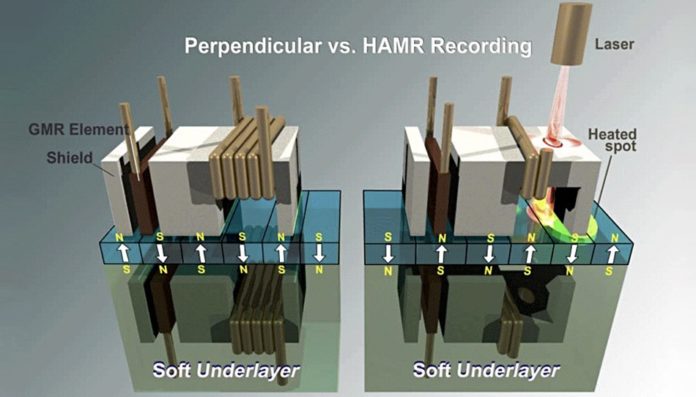Seagate has a second-generation 30TB HAMR disk drive in development, and sees Gen-1 HAMR as having limited appeal.
Heat-Assisted Magnetic Recording (HAMR) is Seagate’s chosen technology to increase disk drive areal density beyond the limits of current perpendicular magnetic recording (PMR) technology, and uses laser-produced local bit area heating to make a hardened magnetic material accept a write signal and then hold it in a stable fashion. Seagate is shipping a Gen-1 20TB HAMR drive in a limited way.
Not for public consumption
Blessed Seeking Alpha published a transcript of a September 15 Q&A session between Seagate CFO Gianluca Romano and Citi MD and senior analyst Jim Suva at a Citi 2021 Global Technology Virtual Conference.

Suva’s first statement included this gem: “I want to go over a few housekeeping items first. First is, no media or press are allowed on this conference call or this video connect. If you are media or press, please disconnect immediately.” Oh, how we laughed when we read this on the Seeking Alpha transcript. It implies that what follows is not for public consumption, which is intriguing.
Romano was very confident in the growth prospects for high-capacity, 3.5-inch disk drives: “We are very confident that the mass capacity part of the business will continue to grow very strongly. We said in the past we expect volume to grow about 35 per cent CAGR for the next several years. … [with] cloud and video and image applications as the segments that are growing the most.”
Key to this growth is continuing to increase disk capacity and so keep up with, or even surpass, competitors Western Digital and Toshiba. Hence the importance of HAMR.
Romano said: “We have a 20-terabyte HAMR that we actually started to sell December last year. That is a small-capacity drive for that new technology. So we are now ramping in volume. We are just producing enough quantity that we can sell to our main customers so that they get familiar with the new drive, with the new technology.” This is why we made the “limited appeal” comment in our first paragraph above.

Then Romano said: “In the meantime, we are developing our second-generation HAMR drive that will be probably around 30 terabyte. That is the drive that we want to ramp in volume.” In our view this means the 20TB HAMR drive is not “the drive we want to ramp in volume.”
The HAMR tech should enable a 50TB HAMR drive in Seagate’s fiscal 2025 year and a 100TB drive “at least by 2030.”
Demarcation
Suva asked Romano which applications would use a 20TB PMR drive and which a 20TB HAMR drive. Romano made a somewhat surprising reply: “The high volume will go to the PMR, the 20-terabyte PMR. For HAMR, I think the best solution is to wait for [the] next generation when another drive will be a 30-terabyte drive, that will be at the beginning, focused only on cloud applications, while PMR will be used for our enterprise OEM, for video image application and some of the legacy applications.”
We understand Seagate is currently sampling a 20TB PMR drive. Even the 30TB HAMR drive will not be applied across Seagate’s disk product range. And, in an implied question here, what capacity will the Seagate PMR drives be at that point?
HAMR technology could also be used to produce what Romano called a “mid-cap” drive in the future.
A snapshot of the timescales Romano revealed:
- 2021 — 20TB PMR and 20TB HAMR;
- Some time between 2022 and 2025 — 30TB HAMR;
- FY 2025 — 50TB HAMR;
- 2030 — 100TB HAMR.
Our take
Our thinking is that Western Digital (WD) has reached the 20TB capacity level using ePMR (enhanced PMR) and embedded flash in the drive controller — its OptiNAND technology. It’s going to extend areal density using these technologies to reach 50TB in the 2025–2030 time period.
WD can also use OptiNAND to increase the slow write performance of its 20TB shingled disk drives and push their capacity to 22 to 24TB and beyond, in our view.
The apparent big puzzle here is how Seagate can increase the areal density of its PMR drives and keep up with WD as it pushes its ePMR/OptiNAND conventional (non-shingled) drive capacity up to the 30TB area. We have had an interview with Colin Presly, a Senior Director in Seagate CTO John Morris’s organisation, and he explained how Seagate will be very competitive in the future, both by extending PMR technology and developing HAMR. A follow-up article based on what he said discusses Seagate’s approach to increasing areal density and performance.








